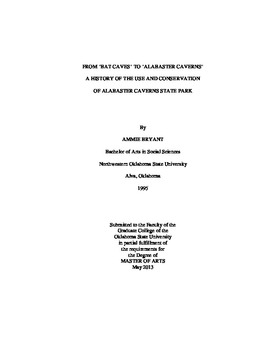| dc.description.abstract | The history of the human use and exploration of Alabaster Caverns reflects the emergence of American environmentalism during the twentieth century. The progression of the management of Alabaster Caverns from exploitation and resource extraction to conservation, preservation, and education also mirrors the public's evolving beliefs, attitudes, and actions regarding environmentalism. The community's exploitation and extraction of natural resources in the caverns, and their attitudes of appreciation of the park, have often overlapped and sometimes worked against one another. Alabaster Cavern's story of human exploration, exploitation, and conservation emerged throughout the twentieth century and continued into the twenty-first along with the American environmentalism movement.Alabaster Caverns' story predates the establishment of state parks in Oklahoma, with the first homesteaders arriving in the area as a result of the Land Run of 1893 that opened the Cherokee Outlet. During the early days of its exploration, the system of caves that make up the park were called the Bat Caves because of the large bat population that could be seen emerging from the caves each evening at sunset. Over the next three decades, area residents discovered that although the land above the caves proved unfit for farming, there were resources below the surface that they could extract for economic gain, including mining the caves for gypsum, bat guano, and alabaster. Throughout each transfer of ownership or lease agreement, the caves provided a local playground for area visitors seeking a day of adventure, ultimately leading to the acquisition of the property by the State of Oklahoma for the development of a state park. Over the past sixty years, the State of Oklahoma's management policies dictating the use and preservation of Alabaster Caverns have continued to evolve into a stewardship advocating conservation, preservation, and education. | |
